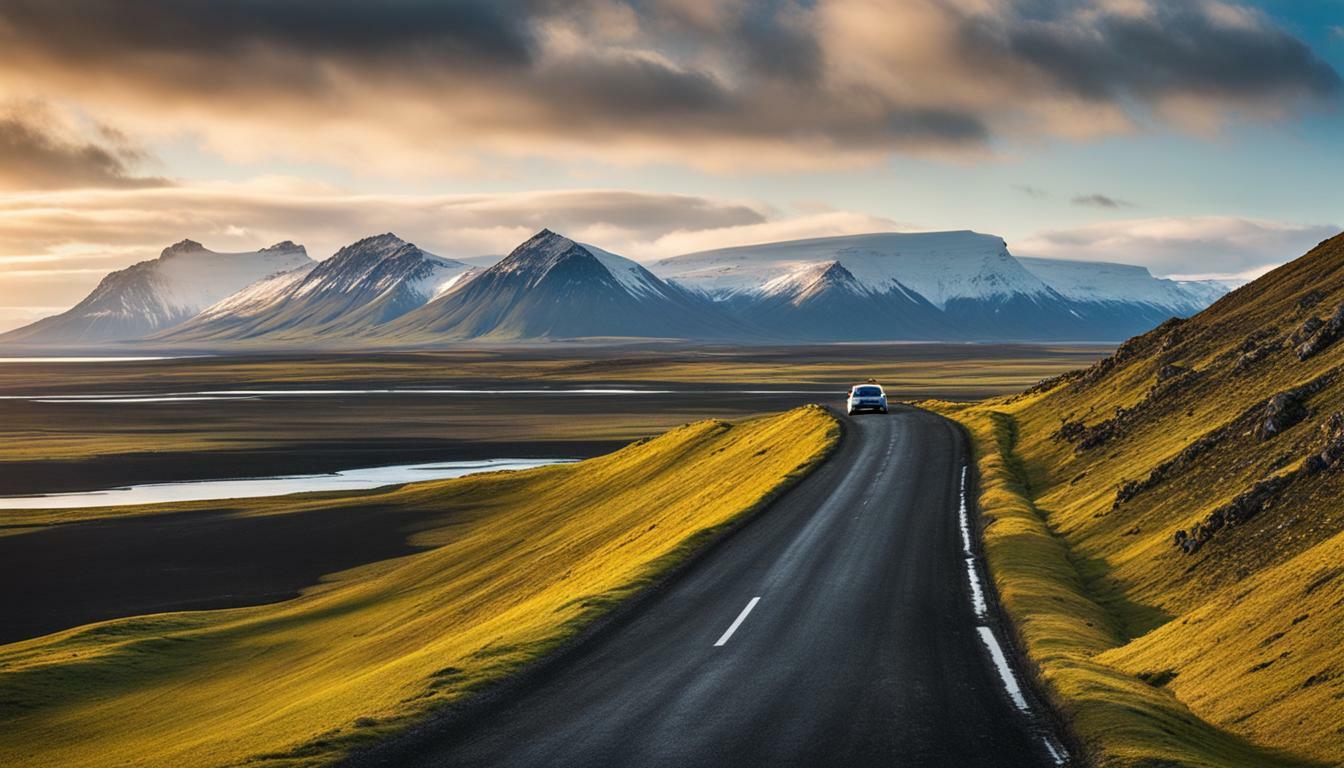Driving in Iceland
Experience the thrill of driving in Iceland and explore its breathtaking landscapes with these essential driving tips. Before embarking on your Iceland road trip, it is crucial to familiarize yourself with the driving rules and regulations in the country.
In Iceland, you drive on the right side of the road, similar to driving in the United States. Overtaking is done on the left side. Ensuring your safety is a priority, seatbelt use is mandatory for all passengers, and it is illegal to drive without one. Additionally, the use of mobile phones while driving is prohibited unless you are using a hands-free device.
Iceland offers a variety of road types, but the most popular route is the Ring Road, also known as Route 1. This well-maintained road is mostly paved and suitable for 2-wheel-drive vehicles. However, if you plan to venture into the highlands and explore the F-Roads, which are dirt mountain roads, a 4-wheel-drive vehicle is necessary.
Before setting off on your journey, it is essential to check weather and road conditions, especially during the winter season. Iceland's weather can be unpredictable, and ensuring your safety is paramount. Additionally, be cautious of sheep crossing the road and refrain from driving off-road, as it is illegal and can cause harm to the environment.
When parking in Reykjavik, the capital city of Iceland, it is important to be aware of the different parking zones and their regulations. Adhering to these regulations will help you avoid penalties and ensure a smooth parking experience.
Key Takeaways:
- Driving in Iceland follows right-hand traffic rules, similar to the United States.
- Seatbelt use is mandatory, and it is illegal to drive without one.
- Using mobile phones while driving is prohibited, unless in hands-free mode.
- The Ring Road (Route 1) is the most popular route, suitable for 2-wheel-drive vehicles.
- Exploring the F-Roads in the highlands requires a 4-wheel-drive vehicle.
Road Conditions and Regulations in Iceland
Familiarize yourself with the driving rules and regulations in Iceland, from driving on the right side to exploring the popular Ring Road for an unforgettable road trip. In Iceland, we drive on the right side of the road, similar to driving in the United States. Overtaking is done on the left, and it is important to follow these rules to ensure a smooth and safe journey.
“Driving on the right side of the road in Iceland is like driving in the United States, which makes it easier for American visitors to adapt,” says John Smith, a seasoned traveler who has experienced the joys of an Iceland road trip.
“The driving experience in Iceland is truly unique. The landscapes are breathtaking, and the roads are well-maintained, especially the popular Ring Road (Route 1). It's a must-visit destination for any road trip enthusiast.”
Seatbelt use is required by law in Iceland, and it is illegal to drive without wearing one. Additionally, the use of mobile phones while driving is strictly prohibited unless using a hands-free device. These regulations ensure the safety of all drivers and passengers on the road.
When planning your road trip, take into consideration the road conditions and the type of vehicle you will be driving. The Ring Road is mostly paved and well-maintained, making it accessible with a 2-wheel-drive vehicle. However, if you plan to venture into the highlands and explore the F-Roads, which are dirt mountain roads, a 4-wheel-drive vehicle is necessary. These rugged terrains require a vehicle with more traction and stability.
Driving Tip:
- Check the weather and road conditions before your journey, especially during the winter season. Weather conditions can change rapidly in Iceland, and it's important to be prepared for any challenges you may encounter.
- Be cautious of sheep crossing the road, especially in rural areas. Slow down and give them plenty of space to pass safely.
- Avoid driving off-road as it is illegal and can cause significant damage to the fragile Icelandic environment.
When you arrive in Reykjavik, it's essential to understand the parking regulations. Different parking zones have varying prices, and it's important to adhere to these regulations to avoid fines. Take the time to familiarize yourself with the parking zones and make informed decisions about where to park your vehicle.
In summary, driving in Iceland offers a thrilling experience filled with stunning landscapes and unforgettable road trips. Familiarize yourself with the driving rules and regulations, choose the right vehicle for your adventure, and take necessary precautions to ensure a safe and enjoyable journey. Always remember to follow the rules of the road and respect the unique nature of this beautiful country.
Choosing a Rental Car for Your Iceland Adventure
Discover the essentials of renting a car in Iceland, including the need for a suitable vehicle for winter driving adventures. When planning your trip to Iceland, renting a car is a popular choice to explore the stunning landscapes and discover hidden gems at your own pace. However, it is crucial to choose a rental car that suits the unique driving conditions you may encounter, especially during the winter season.
First and foremost, it is important to consider the size of the vehicle. While compact cars are suitable for most of Iceland's main roads, if you plan to venture off the beaten path and explore the more remote areas, a 4-wheel-drive vehicle is recommended. These vehicles provide better traction and stability on icy or snowy roads, ensuring a safer and more enjoyable driving experience. Be sure to check with your rental car company if they offer 4-wheel-drive options to accommodate your winter driving needs.
Another factor to consider is the inclusion of winter tires. It is compulsory in Iceland to have winter tires on your rental car during the winter months (from November 1st to April 14th) to ensure better grip on icy or snowy roads. Many rental car companies offer cars equipped with studded or non-studded winter tires, so be sure to inquire about this when making your reservation.
| Key Considerations for Renting a Car in Iceland |
|---|
| Choose a vehicle size appropriate for your travel plans |
| Opt for a 4-wheel-drive vehicle for winter driving adventures |
| Ensure winter tires are included in your rental car |
It is also worth considering additional extras that may enhance your driving experience, such as a GPS navigation system or a Wi-Fi hotspot in the car. These extras can be valuable tools for navigating Iceland's remote roads and staying connected during your journey.
By selecting a rental car suited for the unique driving conditions in Iceland, you can embark on your adventure with confidence, knowing that you have chosen a vehicle that will handle the winter roads and offer a comfortable and safe driving experience.
Car Rental Essentials for Winter Driving in Iceland:
- Choose a suitable vehicle size
- Opt for a 4-wheel-drive vehicle
- Ensure inclusion of winter tires
- Consider additional extras like GPS or Wi-Fi
Road Safety and Precautions
Prioritize safety during your Iceland road trip by staying informed about weather and road conditions, and avoiding off-road driving. Iceland's unpredictable weather can quickly turn from calm to extreme, so it's essential to check the forecast regularly and be prepared for changing conditions. Snowstorms, high winds, and icy roads are common during the winter season, making driving more challenging. Always drive cautiously and adjust your speed accordingly.
When embarking on an off-road adventure in Iceland, remember that it is illegal and damaging to the environment. Off-road driving can lead to irreversible destruction of delicate ecosystems and landscapes. To preserve the natural beauty of Iceland for future generations, stick to designated roads and trails. If you want to venture off the beaten path, consider joining a guided tour or seeking advice from local experts who can recommend safe and environmentally responsible routes.
Another important factor to keep in mind while driving in Iceland is the possibility of encountering sheep on the road. Sheep are free to roam across the country, and they often find themselves crossing roads unexpectedly. Be vigilant and reduce your speed when approaching areas known for sheep grazing. Remember, hitting a sheep can cause substantial damage to your vehicle and potentially harm the animal.
In summary, prioritizing safety during your Iceland road trip is crucial. Stay informed about weather and road conditions, follow the rules and regulations, and avoid off-road driving. By respecting Iceland's natural environment and wildlife, you can have a memorable and responsible driving experience in this stunning country.
Parking in Reykjavik
Learn about the parking regulations in Reykjavik to ensure a hassle-free experience during your stay. Reykjavik, the capital city of Iceland, offers various parking options for residents and visitors alike.
When parking in Reykjavik, it is important to be aware of the different parking zones and their regulations. The city is divided into multiple zones, each with its own parking fees and time restrictions. The zones are color-coded, making it easy to identify the parking rules in each area.
For example, the downtown area, known as the blue zone, has the highest parking rates and the shortest time limits. It is designed to encourage turnover and prioritize short-term parking for shopping and dining purposes. On the other hand, the red and green zones have longer time limits and lower parking rates, making them suitable for longer stays.
It is worth noting that parking in Reykjavik is enforced from Monday to Saturday, with no charge for parking on Sundays. However, it is still necessary to adhere to the parking time limits to avoid fines or towing. It is recommended to read and follow the parking signs carefully to avoid any confusion.
| Parking Zone | Color | Time Limit | Parking Rate |
|---|---|---|---|
| Downtown (Blue Zone) | Blue | Max 2 hours | Higher rates |
| Central (Red Zone) | Red | Max 4 hours | Lower rates |
| Residential (Green Zone) | Green | Max 24 hours | Lower rates |
Remember to always check the parking signs to ensure you are parked legally and avoid any unnecessary fines or inconveniences.
In addition to street parking, Reykjavik also offers parking garages and lots for those who prefer covered parking. These facilities provide a convenient option, especially during inclement weather or for longer-term parking. The fees for parking garages and lots vary depending on the location.
Overall, understanding the parking regulations in Reykjavik is essential for a seamless experience during your stay. By following the rules and regulations, and being aware of the different parking zones and their restrictions, you can enjoy your time in Reykjavik without any parking-related concerns.
Conclusion
Driving in Iceland allows you to immerse yourself in its natural beauty, but remember to follow the regulations and take necessary precautions to ensure a memorable and safe journey.
Before you hit the road, familiarize yourself with the driving rules and regulations in Iceland. Similar to driving in the United States, you drive on the right side of the road and overtake on the left. Seatbelt use is mandatory, and it is illegal to drive without one. Using mobile phones while driving is also prohibited, unless you have a hands-free device.
The road conditions in Iceland vary, with the Ring Road (Route 1) being the most popular route. This well-maintained road is mostly paved and suitable for 2-wheel-drive vehicles. However, if you plan to explore the F-Roads in the highlands, a 4-wheel-drive vehicle is necessary due to the dirt mountain roads.
It's crucial to check weather and road conditions before embarking on your journey, especially during the winter season. Taking precautions and being aware of sheep crossing the road are essential for a safe trip. Additionally, it is important to avoid driving off-road, as it is illegal and can cause harm to the environment.
When parking in Reykjavik, be mindful of the different parking zones and their regulations. Adhering to these regulations will help you avoid any penalties and ensure a hassle-free experience.
Overall, driving in Iceland offers a unique opportunity to explore its breathtaking landscapes. By following the rules and regulations, and taking necessary precautions, you can enjoy a memorable and safe journey through this incredible country.
FAQ
What side of the road do you drive on in Iceland?
In Iceland, you drive on the right side of the road, similar to driving in the United States.
Is it mandatory to wear seatbelts while driving in Iceland?
Yes, seatbelt use is required by law in Iceland, and it is illegal to drive without one.
Can I use my mobile phone while driving in Iceland?
No, the use of mobile phones while driving is prohibited in Iceland, unless you are using a hands-free device.
What is the most popular road for driving in Iceland?
The Ring Road (Route 1) is the most popular route for road trips in Iceland. It is mostly paved and well-maintained, and a 2-wheel-drive vehicle is sufficient for traveling on it.
Do I need a 4-wheel-drive vehicle for driving in Iceland?
While a 2-wheel-drive vehicle is suitable for the Ring Road, if you plan to explore the F-Roads, which are dirt mountain roads in the highlands, a 4-wheel-drive vehicle is necessary.
What should I consider before embarking on a road trip in Iceland?
It is important to check weather and road conditions before your journey, especially during the winter season. Additionally, be cautious of sheep crossing the road and avoid driving off-road, as it is illegal and can damage the environment.
What are the parking regulations in Reykjavik?
In Reykjavik, there are different parking zones with varying prices. It is important to adhere to the parking regulations to avoid penalties.



